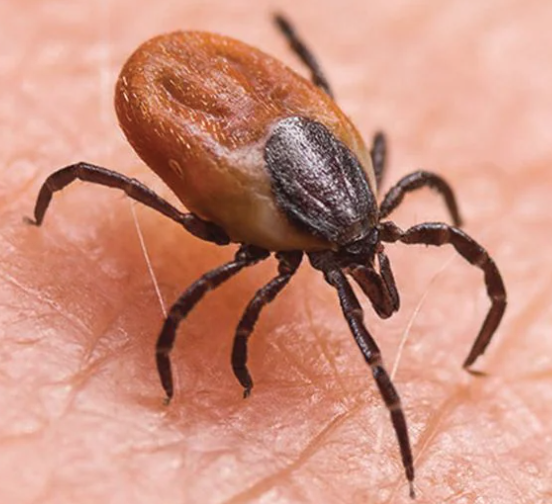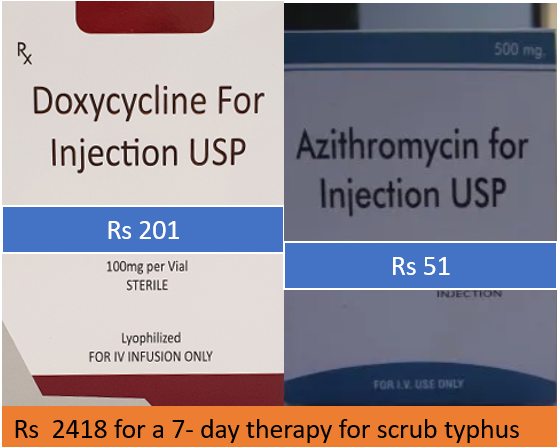
𝗦𝗰𝗿𝘂𝗯 𝘁𝘆𝗽𝗵𝘂𝘀 is a devastating disease. At Sevagram, our healthcare providers regularly care for hundreds of patients with severe scrub typhus in the ICU. Unfortunately, around 15% of these patients do not survive.
A study from India published a day before in the 𝗡𝗲𝘄 𝗘𝗻𝗴𝗹𝗮𝗻𝗱 𝗝 𝗠𝗲𝗱𝗶𝗰𝗶𝗻𝗲 caught my attention. CMC Vellore, PGI Chandigarh and JIPMER, Puducherry were some of the institutes that participated in the study.
This multicenter, double-blind, randomized, controlled three-arm trial from India investigated which treatment (doxycycline, azithromycin, or their combination) was most effective in preventing death, complications, and fever.
The study enrolled 809 patients with severe scrub typhus, who were randomized to receive one of the three treatments for seven days while in the hospital. The researchers analyzed the data of 794 patients, with 265 in the doxycycline group, 263 in the azithromycin group, and 266 in the combination therapy group.
The median age of the patients was 48 years, and 54% were male. Additionally, 15% of the patients had diabetes mellitus, and 12% had hypertension. The patients in the study suffered from various complications, including respiratory problems (62%), hepatic issues (54%), cardiovascular issues (42%), renal problems (30%), and neurological problems (20%).
The researchers found that the patients who received the combination of doxycycline and azithromycin had a 𝟭𝟱% 𝗯𝗲𝘁𝘁𝗲𝗿 𝗰𝗵𝗮𝗻𝗰𝗲 𝗼𝗳 𝗱𝗼𝗶𝗻𝗴 𝘄𝗲𝗹𝗹 compared to those who received just one of the antibiotics.
Although the three groups did not differ in terms of the number of deaths (11% to 13%) or need for support systems like a ventilator or dialysis or inotrope support, the combination therapy was more effective overall in preventing complications and persistent fever. The time it took to get rid of the fever was similar in all three groups.
The researchers believe that using both antibiotics together may help prevent and resolve the severe symptoms of scrub typhus more quickly by better controlling the bacteria during the first week of infection. However, the exact reasons for this are still unknown, and more research is needed to fully understand the mechanism behind their findings.
In patients with severe scrub typhus, 𝗱𝗼𝘅𝘆𝗰𝘆𝗰𝗹𝗶𝗻𝗲 𝗽𝗹𝘂𝘀 𝗮𝘇𝗶𝘁𝗵𝗿𝗼𝗺𝘆𝗰𝗶𝗻 𝘄𝗮𝘀 𝘀𝘂𝗽𝗲𝗿𝗶𝗼𝗿 𝘁𝗼 𝗲𝗶𝘁𝗵𝗲𝗿 𝘁𝗿𝗲𝗮𝘁𝗺𝗲𝗻𝘁 𝗮𝗹𝗼𝗻𝗲 in terms of a composite outcome of death, persistent complications, and persistent fever.
This study shows that using two antibiotics, doxycycline and azithromycin, together is more effective at fighting 𝙊. 𝙩𝙨𝙪𝙩𝙨𝙪𝙜𝙖𝙢𝙪𝙨𝙝𝙞—the bacterium that causes scrub typhus—than using just one antibiotic alone.
The reason for this is that the combination of antibiotics completely stops the bacterium from making proteins, which is crucial for its survival.
If the bacteria that causes scrub typhus is better controlled during the first week of infection, it’s possible that people could recover from severe symptoms more quickly.
O. tsutsugamushi is a tricky bacterium that can hide inside cells in the body, so it’s really important that the antibiotics get inside these cells too. Azithromycin is good at getting inside cells and staying there, which makes it very useful against this type of bacteria.
Of note, the combination therapy did not result in fewer deaths or reduced need for support systems in the ICU compared to using just one antibiotic. But it was still more effective overall in preventing complications and persistent fever.
We don’t know the reason why the antibiotic combo turned out to be more effective. We need further research to determine why.
The findings have the potential to change the way severe scrub typhus is treated in India.

Let me also calculate the cost of the treatment. To complete a 7-day therapy for scrub typhus at Sevagram hospital ICU, what would be the overall expense? The total cost would amount to 𝗥𝘀 𝟮𝟰𝟭𝟴, 𝘄𝗵𝗶𝗰𝗵 𝗶𝗻𝗰𝗹𝘂𝗱𝗲𝘀 𝗥𝘀 𝟮𝟬𝟭𝟬 𝗳𝗼𝗿 𝗗𝗼𝘅𝘆𝗰𝘆𝗰𝗹𝗶𝗻𝗲 𝗮𝗻𝗱 𝗥𝘀 𝟰𝟬𝟴 𝗳𝗼𝗿 𝗔𝘇𝗶𝘁𝗵𝗿𝗼𝗺𝘆𝗰𝗶𝗻.